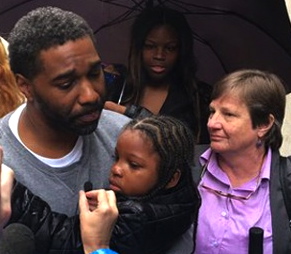 (Photo of Bryant with defense attorney Michele Nethercott-WBAL-TV\Lowell Melser) On a rainy evening of November 20, 1998, 16-year-old Toni Bullock and her 17-year-old friend, Tyeisha Powell, were confronted by a knife-wielding man who dragged them into a vacant lot in Baltimore, Maryland. Bullock was stabbed to death after her friend managed to escape.
Powell gave a description of the attacker based on the few seconds she had to view him in the rainy darkness, from which the police produced a composite sketch. The police tracked more than three dozen leads without an arrest. But a week later, a friend of Bullock’s family told them that he had just been released from the Baltimore Central Booking and Intake Center and that a man he saw in custody, 24-year-old Malcolm Bryant, resembled the composite.
Police presented a photographic lineup to Powell, who identified Bryant as the man who attacked her and Bullock.
Bryant was charged with first-degree murder and illegal use of a weapon. He went to trial in Baltimore City Circuit Court in the summer of 1999. Powell identified Bryant as the man who grabbed them. Defense witnesses testified that Bryant was at a nightclub at the time of the crime. On August 5, 1999, the jury convicted Bryant of murder and illegal use of a weapon. He was sentenced to life in prison.
After his appeals failed, the University of Baltimore Law School’s Innocence Project Clinic, headed by public defender Michele Nethercott, began re-investigating the case.
In 2009, a petition for DNA testing was filed and in 2011, fingernail clippings taken from Bullock were sent for testing. The testing revealed a partial DNA profile of a male, which had a rare identifier, which Bryant did not have. Several more rounds of DNA tests were performed and in 2015, a full DNA profile was obtained from Bullock’s T-shirt—where the fatal wound was inflicted. That profile contained the same rare identifier and matched the partial profile taken from the fingernail clippings. (At trial, a forensic analyst for the Baltimore Police Department had testified DNA testing wasn’t possible because all the fingernail evidence had been “consumed” in initial testing.)
In January 2016, Nethercott filed a motion for a new trial. The Baltimore State’s Attorney’s Office Conviction Integrity Unit, headed by Assistant State’s Attorney Lauren Lipscomb, began a separate investigation of the case.
Four months later, on May 11, 2016, Lipscomb joined in Nethercott’s motion for a new trial. The motion was granted and Lipscomb then dismissed the charges.
“The only plausible explanation we have for the male DNA’s presence under the victim’s fingernails and in the area of the fatal wound on the victim’s T-shirt is that the DNA is in fact the killer’s DNA and does not match Malcolm Bryant,” Lipscomb said. “This in all probability means Mr. Bryant is not the murderer.”
Baltimore State’s Attorney Marilyn Mosby said, “On behalf of the criminal justice system, I’d like to apologize to Mr. Malcolm Bryant and his family for the pain they’ve endured as a result of his wrongful conviction.”
After Bryant’s release, an ad hoc review team that included police, prosecutors and the public defender’s office, examined the case and found substantial problems in the police department's handling of the case. For example, there were other composite drawings created, including at least one that closely resembled the alternate suspect, whose DNA was found on Bullock’s clothing, but these were not given to Bryant's defense team or to prosecutors. This man has not been charged, and is not named in court documents.
In addition, several people had indicated seeing the alternate suspect in the vicinity of the crime scene and wearing a coat similar to one described by Powell. When Investigator William Ritz finally interviewed this man, the officer’s questions appeared to be aimed at eliminating the man as a suspect.
The report said Ritz’s questioning of the alternate suspect “consisted mainly of leading questions that clearly showed the desired direction of the interviewing officer. These questions, coming from an experienced interviewer, were seemingly designed to prevent [the man] from providing information that might have contradicted the then-current investigational conclusions [implicating Malcolm Bryant]. “
Bryant died of a stroke in March 2017. His estate filed a claim in 2018 with the Maryland Board of Public Works for $2 million in compensation for his wrongful conviction. In 2019, his sons filed a federal lawsuit against the Baltimore Police Department and two of its employees. In that lawsuit, they said that the police department’s forensic analyst had testified falsely when he said the initial testing of Bullock’s fingernails for blood had “consumed” all the evidence.
The federal lawsuit was settled in January 2022, with the city agreeing to pay Bryant’s estate $8 million.
– Maurice Possley
|